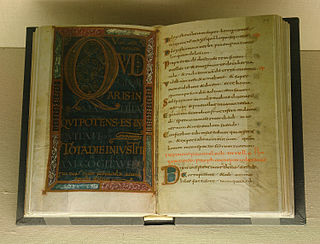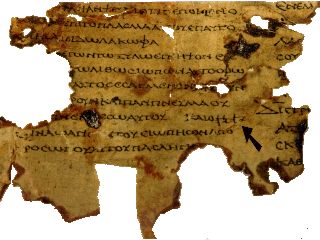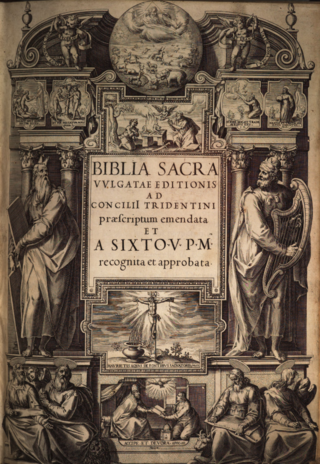Related Research Articles

The Vulgate is a late-4th-century Latin translation of the Bible. It is largely the work of St. Jerome who, in 382, had been commissioned by Pope Damasus I to revise the Vetus Latina Gospels used by the Roman Church. Later, of his own initiative, Jerome extended this work of revision and translation to include most of the books of the Bible.

Vetus Latina, also known as Vetus Itala, Itala ("Italian") and Old Italic, and denoted by the siglum , is the collective name given to the Latin translations of biblical texts that preceded the Vulgate.
Carlo Vercellone was an Italian biblical scholar.

There exist a number of translations of the Book of Psalms into the Latin language. They are a resource used in the Liturgy of the Hours and other forms of the canonical hours in the Latin liturgical rites of the Catholic Church.
Giuseppe Bianchini was an Italian Oratorian, biblical, historical, and liturgical scholar. Clement XII and Benedict XIV, who highly appreciated his learning, entrusted him with several scientific labors. Bianchini had contemplated a large work on the texts of the Bible, Vindiciæ Canonicarum Scripturarum Vulgatæ latinæ editionis, which was to comprise several volumes, but only the first, in which, among other things, are to be found fragments of the Hexapla, was published. Much more important is his Evangeliarium quadruplex latinæ versionis antiquæ, etc., 2 vols.. Among his historical works may be mentioned the fourth volume which Bianchini added to the publication of his uncle, Francesco Bianchini, Anastasii bibliothecarii Vitæ Rom. Pontif. ; he also published the Demonstratio historiæ ecclesiasticæ quadripartitæ. The chief liturgical work of Bianchini is Liturgia antiqua hispanica, gothica, isidoriana, mozarabica, toletana mixta. He also undertook the edition of the works of B. Thomasius (Tomasi), but only one volume was issued.

The earliest surviving manuscripts of the Septuagint, an ancient translation of the ancient Hebrew Torah into Koine Greek, include three 2nd century BCE fragments from the books of Leviticus and Deuteronomy and five 1st century BCE fragments of Genesis, Exodus, Leviticus, Numbers, and Deuteronomy, only. The vast majority of Septuagint manuscripts are late-antiquity and medieval manuscript versions of the Christian Greek Old Testament tradition.

Codex Vaticanus 354, formerly called Codex Guelpherbytanus, is a Greek manuscript of the four Gospels written on parchment. It is designated by S or 028 in the Gregory-Aland numbering of New Testament manuscripts, and ε 1027 in the von Soden numbering of New Testament manuscripts. A colophon on the reverse side of folio 234 lists the production date as 949 CE. This manuscript is one of the four oldest New Testament manuscripts dated in this manner, and the only dated uncial. The manuscript has complex contents.

Codex Cyprius, designated by Ke or 017, ε71, or Codex Colbertinus 5149, is a Greek uncial manuscript of the four Gospels, written on parchment. It is one of the few uncial manuscripts with the complete text of the four Gospels, and it is one of the more important late uncial manuscripts. It was brought from Cyprus to Paris.

Codex Angelicus designated by Lap or 020, α 5, is a Greek uncial manuscript of the New Testament. Palaeographically it has been assigned to the 9th century. Formerly it was known as Codex Passionei.
Codex Vaticanus 2066, designed by 046 (in the Gregory-Aland numbering), α 1070 (von Soden), formerly it was known also as Codex Basilianus, previously it was designated by Br or B2. It is a Greek uncial manuscript of the New Testament written on vellum. The manuscript paleographically has been assigned to the 10th century by the INTF, though some palaeographers proposed the 9th century. Scrivener proposed even the 8th century.
Minuscule 169, ε 305 (Soden), is a Greek minuscule manuscript of the New Testament, on parchment. Palaeographically, it has been assigned to the 11th century. It has marginalia.

The Codex Veronensis, designated by the siglum b or 4, is a 5th-century Latin manuscript of the four Gospels, written on vellum which has been dyed purple. The text is written in silver and occasionally gold ink, and is a version of the old Latin New Testament Gospels. The Gospels follow in the Western order.
Lectionary 125, designated by siglum ℓ125 is a Greek manuscript of the New Testament, on parchment leaves. Palaeographically it has been assigned to the 11th century.
Lectionary 126, designated by siglum ℓ126 is a Greek manuscript of the New Testament, on parchment leaves. Palaeographically it has been assigned to the 11th century.
Minuscule 627, α 53, is a Greek minuscule manuscript of the New Testament, on parchment. Palaeographically it has been assigned to the 10th century. The manuscript is lacunose. Tischendorf labelled it by 160a, 193p, and 24r. It has unusual order of books: the Book of Revelation is placed between Book of Acts and the Catholic epistles.

The Sixtine Vulgate or Sistine Vulgate is the edition of the Vulgate—a 4th-century Latin translation of the Bible that was written largely by Jerome—which was published in 1590, prepared by a commission on the orders of Pope Sixtus V and edited by himself. It was the first edition of the Vulgate authorised by a pope. Its official recognition was short-lived; the edition was replaced in 1592 by the Sixto-Clementine Vulgate.

The Sixto-Clementine Vulgate or Clementine Vulgate is an edition of the Latin Vulgate, the official Bible of the Roman Catholic Church. It was the second edition of the Vulgate to be formally authorized by the Catholic Church, the first being the Sixtine Vulgate. The Clementine Vulgate was promulgated in 1592 by Pope Clement VIII, hence its name. The Sixto-Clementine Vulgate was used officially in the Catholic Church until 1979, when the Nova Vulgata was promulgated by Pope John Paul II. The Clementine Vulgate is still in use in the 1962 missal and breviary of the Catholic Church.

The Codex Toletanus, designated by T, also called Biblia hispalense or Seville Bible, is a 10th-century Latin manuscript of the Old and New Testament. The text, written on vellum, is a version of the Latin Vulgate Bible, which contains the entire Bible, including the trinity reference Comma Johanneum.
Codex Turicensis is a 7th-century manuscript of the Psalter in Greek.
The Verona Sacramentary or Leonine Sacramentary is the oldest surviving liturgical book of the Roman rite. It is not a sacramentary in the strict sense, but rather a private collection of libelli missarum containing only the prayers for certain Masses and not the scriptures, the canon or the antiphons. It is named after the sole surviving manuscript, Codex Veronensis LXXXV, which was found in the chapter library of the Verona Cathedral by Giuseppe Bianchini and published in his four-volume Anastasii bibliothecarii vitae Romanorum pontificum in 1735. It is sometimes called "Leonine" because it has been attributed to Pope Leo I, but while some of the prayers may be his compositions the entire work certainly is not.
References
- ↑ R. Weber, Le Psautier Romain, Rome (1953), p.xvii.